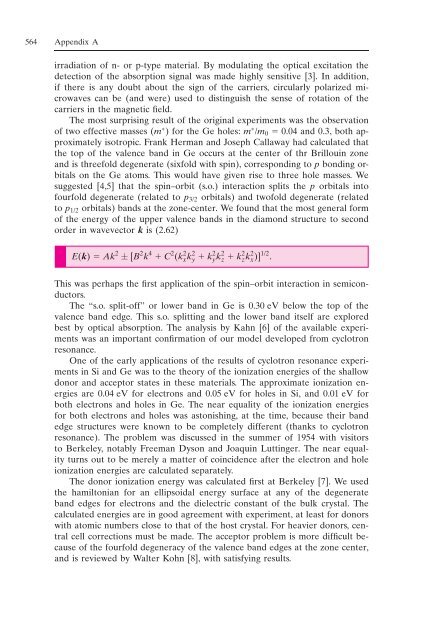10. Appendix
Create successful ePaper yourself
Turn your PDF publications into a flip-book with our unique Google optimized e-Paper software.
564 <strong>Appendix</strong> A<br />
irradiation of n- or p-type material. By modulating the optical excitation the<br />
detection of the absorption signal was made highly sensitive [3]. In addition,<br />
if there is any doubt about the sign of the carriers, circularly polarized microwaves<br />
can be (and were) used to distinguish the sense of rotation of the<br />
carriers in the magnetic field.<br />
The most surprising result of the original experiments was the observation<br />
of two effective masses (m ∗ ) for the Ge holes: m ∗ /m0 0.04 and 0.3, both approximately<br />
isotropic. Frank Herman and Joseph Callaway had calculated that<br />
the top of the valence band in Ge occurs at the center of thr Brillouin zone<br />
and is threefold degenerate (sixfold with spin), corresponding to p bonding orbitals<br />
on the Ge atoms. This would have given rise to three hole masses. We<br />
suggested [4,5] that the spin–orbit (s.o.) interaction splits the p orbitals into<br />
fourfold degenerate (related to p3/2 orbitals) and twofold degenerate (related<br />
to p1/2 orbitals) bands at the zone-center. We found that the most general form<br />
of the energy of the upper valence bands in the diamond structure to second<br />
order in wavevector k is (2.62)<br />
E(k) Ak 2 ± [B 2 k 4 C 2 (k 2 x k2 y k2 y k2 z k2 z k2 x )]1/2 .<br />
This was perhaps the first application of the spin–orbit interaction in semiconductors.<br />
The “s.o. split-off” or lower band in Ge is 0.30 eV below the top of the<br />
valence band edge. This s.o. splitting and the lower band itself are explored<br />
best by optical absorption. The analysis by Kahn [6] of the available experiments<br />
was an important confirmation of our model developed from cyclotron<br />
resonance.<br />
One of the early applications of the results of cyclotron resonance experiments<br />
in Si and Ge was to the theory of the ionization energies of the shallow<br />
donor and acceptor states in these materials. The approximate ionization energies<br />
are 0.04 eV for electrons and 0.05 eV for holes in Si, and 0.01 eV for<br />
both electrons and holes in Ge. The near equality of the ionization energies<br />
for both electrons and holes was astonishing, at the time, because their band<br />
edge structures were known to be completely different (thanks to cyclotron<br />
resonance). The problem was discussed in the summer of 1954 with visitors<br />
to Berkeley, notably Freeman Dyson and Joaquin Luttinger. The near equality<br />
turns out to be merely a matter of coincidence after the electron and hole<br />
ionization energies are calculated separately.<br />
The donor ionization energy was calculated first at Berkeley [7]. We used<br />
the hamiltonian for an ellipsoidal energy surface at any of the degenerate<br />
band edges for electrons and the dielectric constant of the bulk crystal. The<br />
calculated energies are in good agreement with experiment, at least for donors<br />
with atomic numbers close to that of the host crystal. For heavier donors, central<br />
cell corrections must be made. The acceptor problem is more difficult because<br />
of the fourfold degeneracy of the valence band edges at the zone center,<br />
and is reviewed by Walter Kohn [8], with satisfying results.










